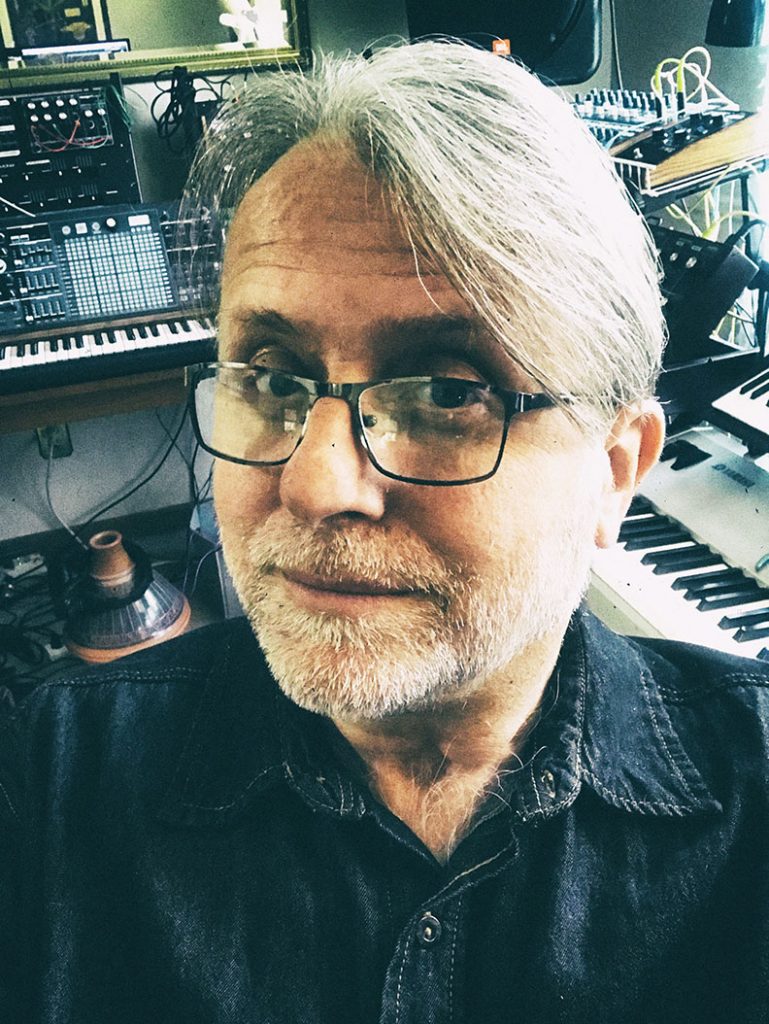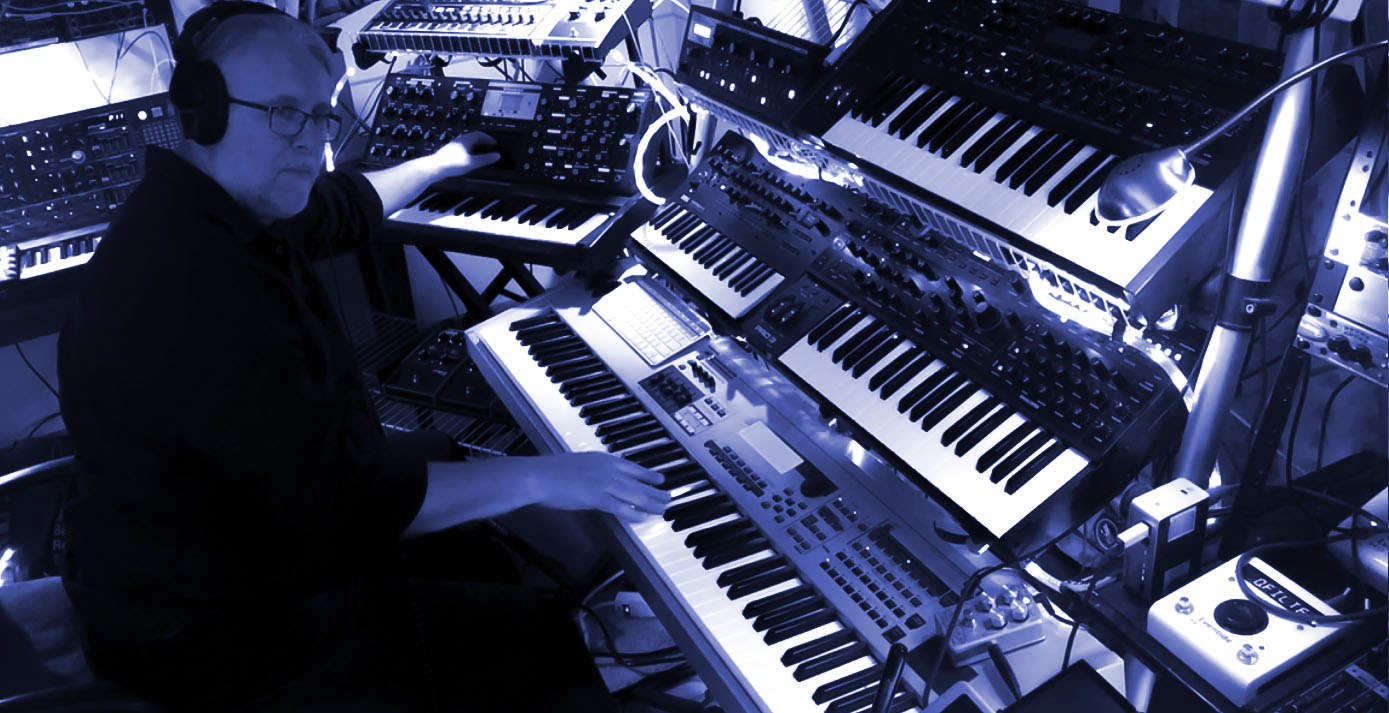By Keith Walsh
Ambient music was one of the earliest forms of popular electronic music, arriving on the scene no later than the 1960s, well before the synthpop explosion of the early 80s. Early experiments by Kraftwerk, Roedelius, Harold Budd and others combined the organic textures of acoustic instruments with the warmth of analog synths.
The new release by American composer Chris Stack combines a classic approach to electronic composition with modern techniques, featuring shakuhachi flute with modeled drums, along with Moog and other analog synths. “Modoru” is an EP that put me in a very relaxed mood. On the occasion of its release I had the chance to ask Stack a few questions in an email exchange.
Synthbeat: These tracks are very slight in structure but there is a solid underlying form. How do you go about composing these?
CS: In a DAW. The title track(s) are basically a remix/reinterpretation of the song Last Wolf on Hokkaido, from my first album “Xenography.” “Modoru” is Japanese for “return”, and that’s what that refers to on the surface, but also hint at returning to things and going deeper.
I do tend to create fairly simple sequences and use them as a springboard for further inspiration.
Synthbeat: Are there rhythmic elements that were taken out? A click track at least?
CS: There might have been a click used on recording a track or two but nothing significant, and nothing significant taken out. A lot of things that probably don’t sound sequenced actually were. I’ve developed a few tricks in that regard over the years.
Synthbeat: What DAW (Digital Audio Workstation) are you using?
CS: Primarily Logic. I also use Ableton quite a bit but generally to create stems that I export and bring into Logic. I never got around to learning Ableton’s arrangement view.

Synthbeat: Can you tell me about the use of sequenced loops in your music?
CS: Logic and Ableton both played a part there. On this EP the more rhythmically complex loopy things tend to be Ableton. Logic has some new pattern-based sequencing functionality that I’ve been having fun exploring, but none of it made it on to this EP yet. Maybe I’ll remix the remix in the future 😉
Synthbeat: What’s the electric piano on track 4 (the ethereal “Two Moons”)?
CS: That’s one of the pianos that come with the Ableton 10 suite. I went in and lowered the filter cutoff to soften it up. I do that on almost all pianos I use.
Synthbeat: Alina Q. Talyad’s vocals (“Two Moons”) are wonderful. What’s her musical background?
CS: Alina’s a great singer and her musical background is very different from this. In addition to her own very-conscious singer/songwriter work she’s the vocalist in “The Gypsy Swingers”, a gypsy jazz/early jazz band. I had a lot of fun running her voice through Eventide and TC Helicon intelligent harmonizers and other effects.
Synthbeat: I get the feeling you’re a hardware synth aficionado. Do you use any virtual synths lately? On this EP?
CS: Yes, I’ve been heavily into synthesizers since the late 70s and have a pretty good collection. I do use virtual too. My first album, “Xenography” was inspired by my purchase of Logic. Suddenly, I had a big virtual playground to explore… and I did. It’s about 75% virtual but still some heavy hardware on it. The track “Reaching Aleppo” (with Sally Sparks) has a pair of DSI Pro 2 on it (that’s Sally shredding the lead on it), a Moog Voyager and a Haken Continuum (also Sally on the Continuum). I play Moog Voyager and/or Moog Guitar on a few other tracks there.
My album “Disambiguation” is pretty hardware-heavy. Lot’s of Arturia MatrixBrute and MicroBrute, DSI Pro 2, and Moog Voyager. A fair amount of softsynths too.
Since “Modoru” is based off material from “Xenography,” it’s more software than hardware. The song 12-winded sky is new material and an exception to that statement. It’s got Arturia MatrixBrute and Moog Slim Phatty doing the plucky, soft metallic timbres, Moog Voyager (sequenced and CV modulated by an Arturia MiniBrute 2S) doing the wet, resonant clock-synced sample & hold lines, and a DSI Pro 2 doing the main pad that runs throughout. Other pads that come in near the end are from Arturia’s fantastic Pigments softsynth. It’s used quite a bit on the other songs too.
Synthbeat:. What are the tuned drums on tracks 1 and 3? And what sounds like the clacking of sticks on 3 ? Where did you get these samples and what is the hardware or software? I can’t pinpoint the exact culture they’re native to.
CS: They are from the Sculpture modelling softsynth that comes with Logic. Cultural influences there are Japanese Taiko drumming (although much slower than usual here) and middle-eastern frame drum playing.
https://chrisstack.bandcamp.com/
Chris Stack On Facebook
Chrisstack.com
finis
